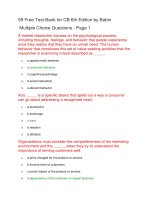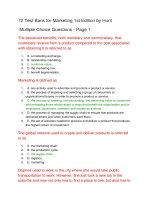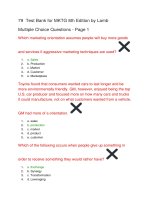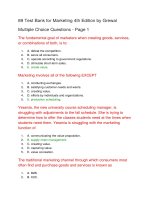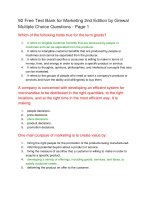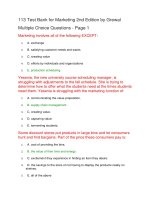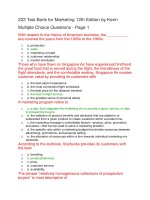Test bank for management 12th edition by schermerhorn
Bạn đang xem bản rút gọn của tài liệu. Xem và tải ngay bản đầy đủ của tài liệu tại đây (87.4 KB, 26 trang )
Full file at />
Test Bank for Management 12th Edition by Schermerhorn
Complete downloadable file at:
/>True or False Questions
1.
Intellectual capital is a personal asset for individuals.
Answer: True
Page: 5
Learning Objective: 1.1
Difficulty: Easy
AACSB: Analytic skills
Bloom’s Taxonomy: Knowledge
2.
Commitment represents your talents or job-relevant capabilities.
Answer: False
Page: 5
Learning Objective: 1.1
Difficulty: Easy
AACSB: Analytic skills
Bloom’s Taxonomy: Knowledge
3.
A knowledge worker is a person whose physical capabilities are the most critical
assets.
Answer: False
Page: 5
Learning Objective: 1.1
Difficulty: Easy
AACSB: Analytic skills
Bloom’s Taxonomy: Knowledge
4.
Tech IQ is the ability to use technology and commitment to stay informed on the
latest technological developments.
Answer: True
Page: 6
Learning Objective: 1.1
Difficulty: Easy
AACSB: Use of information technology
Bloom’s Taxonomy: Knowledge
5.
National boundaries hardly count anymore in the world of business.
Answer: True
Page: 6
Learning Objective: 1.1
Difficulty: Moderate
AACSB: Dynamics of the global economy
Bloom’s Taxonomy: Knowledge
6.
Minorities constitute less than one-third of the U.S. population.
Answer: False
Page: 9
Learning Objective: 1.1
Difficulty: Easy
AACSB: Multicultural and diversity understanding
Copyright © 2012 John Wiley & Sons, Inc.
1-1
Full file at />
Bloom’s Taxonomy: Knowledge
7.
The first leaf in the shamrock organization consists of a core group of “freelancers”
and “independent contractors.”
Answer: False
Page: 10
Learning Objective: 1.1
Difficulty: Easy
AACSB: Analytic skills
Bloom’s Taxonomy: Knowledge
8.
In a free-agent economy, people do not change jobs very often.
Answer: False
Page: 10
Learning Objective: 1.1
Difficulty: Easy
AACSB: Analytic skills
Bloom’s Taxonomy: Knowledge
9.
All organizations are open systems that interact with their environments.
Answer: True
Page: 11
Learning Objective: 1.2
Difficulty: Easy
AACSB: Communication abilities
Bloom’s Taxonomy: Knowledge
10.
Performance effectiveness is defined as the quantity and quality of outputs relative to
the cost of inputs.
Answer: False
Page: 12
Learning Objective: 1.2
Difficulty: Easy
AACSB: Analytic skills
Bloom’s Taxonomy: Knowledge
11.
If a company fails to achieve its desired goals but manages to preserve its resources,
we can say that its productivity is effective but not efficient.
Answer: False
Page: 12
Learning Objective: 1.2
Difficulty: Moderate
AACSB: Analytic skills
Bloom’s Taxonomy: Comprehension
12.
Performance efficiency is an output measure of resource cost associated with goal
accomplishment.
Answer: False
Page: 13
Learning Objective: 1.2
Difficulty: Moderate
AACSB: Analytic skills
Bloom’s Taxonomy: Comprehension
Copyright © 2012 John Wiley & Sons, Inc.
1-2
Full file at />
13.
In the context of present day organizational trends, organizations and their members
are networked for intense, real-time communication and coordination.
Answer: True
Page: 13
Learning Objective: 1.2
Difficulty: Moderate
AACSB: Communication abilities
Bloom’s Taxonomy: Knowledge
14.
A manager is a person who supports, activates, and is responsible for the work of
others.
Answer: True
Page: 14
Learning Objective: 1.3
Difficulty: Easy
AACSB: Analytic skills
Bloom’s Taxonomy: Knowledge
15.
Middle managers are in charge of overseeing the overall operations of the
organization.
Answer: False
Page: 14
Learning Objective: 1.3
Difficulty: Easy
AACSB: Analytic skills
Bloom’s Taxonomy: Knowledge
16.
The top managers of an organization constitute an executive team that is not
accountable to any higher authority in the organization.
Answer: False
Page: 14
Learning Objective: 1.3
Difficulty: Easy
AACSB: Analytic skills
Bloom’s Taxonomy: Knowledge
17.
Top managers are supposed to set strategy and lead the organization consistent with
its purpose and mission.
Answer: True
Page: 14
Learning Objective: 1.3
Difficulty: Easy
AACSB: Analytic skills
Bloom’s Taxonomy: Knowledge
18.
Typical job titles for middle managers include department head, team leader, and
supervisors.
Answer: False
Page: 15
Learning Objective: 1.3
Difficulty: Easy
AACSB: Analytic skills
Bloom’s Taxonomy: Knowledge
Copyright © 2012 John Wiley & Sons, Inc.
1-3
Full file at />
19.
Line managers are responsible for work that makes a direct contribution to the
organization’s outputs.
Answer: True
Page: 15
Learning Objective: 1.3
Difficulty: Easy
AACSB: Analytic skills
Bloom’s Taxonomy: Knowledge
20.
Functional managers are primarily involved in using their special technical expertise
to advise and support line workers.
Answer: False
Page: 15
Learning Objective: 1.3
Difficulty: Easy
AACSB: Analytic skills
Bloom’s Taxonomy: Knowledge
21.
Effective managers successfully help others achieve both high performance and
satisfaction in their work.
Answer: True
Page: 16
Learning Objective: 1.3
Difficulty: Easy
AACSB: Analytic skills
Bloom’s Taxonomy: Knowledge
22.
The upside-down pyramid view of organizations shows customers at the top being
served by workers who are supported by managers.
Answer: True
Page: 17
Learning Objective: 1.3
Difficulty: Easy
AACSB: Analytic skills
Bloom’s Taxonomy: Knowledge
23.
The top managers are primarily responsible for all the four management functions
and the other managers are in charge of any one of the functions.
Answer: False
Page: 18
Learning Objective: 1.4
Difficulty: Easy
AACSB: Analytic skills
Bloom’s Taxonomy: Knowledge
24.
Through controlling, a manager identifies desired results and ways to achieve them.
Answer: False
Page: 18
Learning Objective: 1.4
Difficulty: Easy
AACSB: Analytic skills
Bloom’s Taxonomy: Knowledge
Copyright © 2012 John Wiley & Sons, Inc.
1-4
Full file at />
25.
In the management process, if the planning is impeccable, then there is no need for
controlling.
Answer: False
Page: 20
Learning Objective: 1.4
Difficulty: Moderate
AACSB: Analytic skills
Bloom’s Taxonomy: Comprehension
26.
According to Mintzberg, a manager’s informational roles are limited to being a
figurehead.
Answer: False
Page: 21
Learning Objective: 1.4
Difficulty: Easy
AACSB: Analytic skills
Bloom’s Taxonomy: Knowledge
27.
According to Mintzberg, as a monitor, a manager provides direction and instills
enthusiasm.
Answer: False
Page: 21
Learning Objective: 1.4
Difficulty: Moderate
AACSB: Analytic skills
Bloom’s Taxonomy: Comprehension
28.
Through agenda setting, good managers develop action priorities that include goals
and plans spanning long and short time frames.
Answer: True
Page: 22
Learning Objective: 1.4
Difficulty: Easy
AACSB: Analytic skills
Bloom’s Taxonomy: Knowledge
29.
The learning focus in management is on developing skills and competencies to deal
with the complexities of human behavior and problem solving in organizations.
Answer: True
Page: 23
Learning Objective: 1.5
Difficulty: Easy
AACSB: Analytic skills
Bloom’s Taxonomy: Knowledge
30.
Long-term career success depends mainly on lifelong learning.
Answer: True
Page: 23
Learning Objective: 1.5
Difficulty: Easy
AACSB: Analytic skills
Bloom’s Taxonomy: Knowledge
Copyright © 2012 John Wiley & Sons, Inc.
1-5
Full file at />
31.
A person high in emotional intelligence will know when her or his emotions are about
to become disruptive, but does not usually sense when another person’s emotions are
negatively influencing a relationship.
Answer: False
Page: 24
Learning Objective: 1.5
Difficulty: Moderate
AACSB: Communication abilities
Bloom’s Taxonomy: Comprehension
Multiple Choice Questions
32.
________ is the collective brainpower or shared knowledge of a
workforce that can be used to create value.
A. Social capital
B. Intellectual capital
C. Workforce diversity
D. Productivity
E. Competency
Answer: B
Page: 5
Learning Objective: 1.1
Difficulty: Easy
AACSB: Analytic skills
Bloom’s Taxonomy: Knowledge
The intellectual capital equation states: Intellectual Capital =
A. Competency × Commitment
B. Competency ÷ Commitment
C. Knowledge × Concept
D. Knowledge ÷ Concept
E. Intellect × Talent
Answer: A
Page: 5
Learning Objective: 1.1
Difficulty: Easy
AACSB: Analytic skills
Bloom’s Taxonomy: Knowledge
34.
________ represents one’s willingness to work hard in applying one’s capabilities to
important tasks.
A. Intellect
B. Productivity
C. Commitment
D. Effectiveness
E. Competency
Answer: C
Page: 5
Learning Objective: 1.1
Difficulty: Easy
AACSB: Analytic skills
Bloom’s Taxonomy: Knowledge
Copyright © 2012 John Wiley & Sons, Inc.
1-6
Full file at />
35.
Which of the following is the defining characteristic of knowledge workers?
A. They work only in the information technology industry.
B. They have a high degree of cohesiveness and are prone to groupthink.
C. They are valued for their minds, not just their physical capabilities.
D. They are grouped together for a specific purpose and are disbanded when their
task is completed.
E. They are a part of an unofficial group emerging from relationships and shared
interests among members.
Answer: C
Page: 5
Learning Objective: 1.1
Difficulty: Moderate
AACSB: Analytic skills
Bloom’s Taxonomy: Comprehension
36.
The members of a ________ team are most likely to hold meetings, access common
databases, share information and files, make plans, and solve problems together, all
without ever meeting face to face.
A. virtual
B. specialized
C. cross-functional
D. self-managed
E. formal
Answer: A
Page: 6
Learning Objective: 1.1
Difficulty: Moderate
AACSB: Use of information technology
Bloom’s Taxonomy: Comprehension
37.
________ is the worldwide interdependence of resource flows, product markets, and
business competition.
A. Collectivism
B. Globalization
C. Nationalization
D. Diversification
E. Orientalism
Answer: B
Page: 6
Learning Objective: 1.1
Difficulty: Easy
AACSB: Dynamics of the global economy
Bloom’s Taxonomy: Knowledge
38.
In today’s world, Americans find that their customer service call is
answered in Ghana, their CAT scan read by a radiologist in India, and their tax return
prepared by an accountant in the Philippines. This has become possible primarily due
to ________.
A. collectivism
B. the glass ceiling effect
C. the regional trade agreements
D. globalization
E. distributed leadership
Copyright © 2012 John Wiley & Sons, Inc.
1-7
Full file at />
Answer: D
Page: 6
Learning Objective: 1.1
Difficulty: Moderate
AACSB: Reflective thinking skills
Bloom’s Taxonomy: Comprehension
39.
Which of the following is a negative outcome closely associated with
globalization?
A. Groupthink
B. Functional chimneys problem
C. Job migration
D. National barriers
E. Debt financing
Answer: C
Page: 7
Learning Objective: 1.1
Difficulty: Moderate
AACSB: Dynamics of the global economy
Bloom’s Taxonomy: Comprehension
40.
Job migration occurs primarily:
A. when firms shift jobs from one country to another.
B. due to the ecological fallacy.
C. when workforce diversity increases.
D. when workers move from their home country to another country.
E. due to an increase in the productivity of the workforce.
Answer: A
Page: 7
Learning Objective: 1.1
Difficulty: Moderate
AACSB: Dynamics of the global economy
Bloom’s Taxonomy: Knowledge
41.
Which of the following is defined as the code of moral principles that
sets standards for what is “good” and “right” as opposed to “bad” and “wrong” in the
conduct of a person or group?
A. Synergy
B. Ethics
C. Behavior
D. Cohesiveness
E. Individualism
Answer: B
Page: 7
Learning Objective: 1.1
Difficulty: Easy
AACSB: Ethical understanding and reasoning abilities
Bloom’s Taxonomy: Knowledge
42.
________ describes differences among workers in gender, race, age, ethnicity,
religion, sexual orientation, and able-bodiedness.
A. Ethics
B. Workforce diversity
C. Masculinity-femininity
Copyright © 2012 John Wiley & Sons, Inc.
1-8
Full file at />
D. Creative economy
E. Competency
Answer: B
Page: 9
Learning Objective: 1.1
Difficulty: Easy
AACSB: Multicultural and diversity understanding
Bloom’s Taxonomy: Knowledge
43.
Smith, an employee of Carbon Inc., thinks that business leaders should “be white.”
Owing to this view, he holds a grudge against his manager, Adisa, who is of Asian
origin. Smith often displays defiant behavior at the workplace. Smith’s behavior is an
example of ________.
A. prejudice
B. whistleblowing
C. subordination
D. harassment
E. bullying
Answer: A
Page: 9
Learning Objective: 1.1
Difficulty: Hard
AACSB: Reflective thinking skills
Bloom’s Taxonomy: Application
44.
________ is the display of negative, irrational attitudes toward members of diverse
populations.
A. Job dissatisfaction
B. Subordination
C. Intimidation
D. Whistleblowing
E. Prejudice
Answer: E
Page: 9
Learning Objective: 1.1
Difficulty: Easy
AACSB: Multicultural and diversity understanding
Bloom’s Taxonomy: Knowledge
45.
________ actively denies minority members the full benefits of organizational
membership.
A. Discrimination
B. Subordination
C. Migration
D. Free-riding
E. Social loafing
Answer: A
Page: 9
Learning Objective: 1.1
Difficulty: Easy
AACSB: Multicultural and diversity understanding
Bloom’s Taxonomy: Knowledge
Copyright © 2012 John Wiley & Sons, Inc.
1-9
Full file at />
46.
The ________ effect is an invisible barrier limiting career advancement of women
and minorities.
A. ecological fallacy
B. masculinity-femininity
C. job migration
D. nationalization
E. glass ceiling
Answer: E
Page: 9
Learning Objective: 1.1
Difficulty: Easy
AACSB: Multicultural and diversity understanding
Bloom’s Taxonomy: Knowledge
47.
Karen is the most qualified candidate for the job of marketing
manager at Mob Inc. However, the recruiters do not hire her because they feel that a
woman would not be able to handle the responsibilities associated with such a senior
position. This is an example of the ________ effect.
A. ecological fallacy
B. globalization
C. job migration
D. glass ceiling
E. nationalization
Answer: D
Page: 9
Learning Objective: 1.1
Difficulty: Hard
AACSB: Reflective thinking skills
Bloom’s Taxonomy: Application
48.
The typical characteristic of a(n) ________ is that they typically
operate with a core group of full-time long-term workers supported by others who
work on contracts and part-time.
A. shamrock organization
B. ad hoc team
C. combined task force
D. project team
E. joint task force
Answer: A
Page: 10
Learning Objective: 1.1
Difficulty: Easy
AACSB: Analytic skills
Bloom’s Taxonomy: Knowledge
49.
Which of the following is the defining characteristic of a free-agent
economy?
A. People change jobs more often, and many work on independent contracts with a
shifting mix of employers.
B. The structure is totally centralized and the leader makes all key decisions and
most communication is done by one on one conversations.
C. It consists of boundary less organizations whose employees communicate only
through the virtual media.
Copyright © 2012 John Wiley & Sons, Inc.
1-10
Full file at />
D. In this system organizations are exempted from tax given that they use surplus
revenues to achieve its goals rather than to distribute them as profit.
E. The structure is fully functional and it consists of long-term employees who are
mostly concerned with their respective areas of interest.
Answer: A
Page: 10
Learning Objective: 1.1
Difficulty: Easy
AACSB: Analytic skills
Bloom’s Taxonomy: Knowledge
50.
Which of the following is a typical characteristic of an open system?
A. It is an organization that is convened for a specific purpose and disbands when its
task is completed.
B. It is a system where each member has the authority to make decisions about how
they share and complete their work.
C. It is the system where communication flows only between individual members
and a hub.
D. It is the system in which subgroups have limited communication with one
another.
E. It is a system that transforms resource inputs from the environment into product
outputs.
Answer: E
Page: 11
Learning Objective: 1.2
Difficulty: Easy
AACSB: Analytic skills
Bloom’s Taxonomy: Knowledge
51.
________ accurately measures the quantity and quality of outputs relative to the cost
of inputs.
A. Commitment
B. Productivity
C. Competency
D. Performance efficiency
E. Tech IQ
Answer: B
Page: 12
Learning Objective: 1.2
Difficulty: Easy
AACSB: Analytic skills
Bloom’s Taxonomy: Knowledge
52.
The annual productivity report of Uranus Inc. states that it has
achieved the targets it had set for the year 2011. However in this process, much of its
resources have been wasted and the amount spent on resources is more than the
estimated amount. Its productivity has been:
A. effective and efficient.
B. neither effective nor efficient.
C. not effective but efficient.
D. effective but not efficient.
E. lower as compared to the previous year.
Answer: D
Page: 12
Copyright © 2012 John Wiley & Sons, Inc.
1-11
Full file at />
Learning Objective: 1.2
Difficulty: Hard
AACSB: Reflective thinking skills
Bloom’s Taxonomy: Application
53.
The productivity of a company is neither efficient nor effective when its:
A. goals are not achieved and resources are wasted.
B. goals are achieved and resources are not wasted.
C. goals are achieved but resources are wasted.
D. performance effectiveness is high.
E. goals are not achieved but resources are not wasted.
Answer: A
Page: 12
Learning Objective: 1.2
Difficulty: Moderate
AACSB: Analytic skills
Bloom’s Taxonomy: Comprehension
54.
The productivity of a company is effective and efficient if its:
A. goals are not achieved and resources are wasted.
B. goals are achieved and resources are not wasted.
C. goals are achieved but resources are wasted.
D. performance effectiveness is low.
E. goals are not achieved but resources are not wasted.
Answer: B
Page: 12
Learning Objective: 1.2
Difficulty: Moderate
AACSB: Analytic skills
Bloom’s Taxonomy: Comprehension
55.
________ is an output measure of task or goal accomplishment.
A. Job satisfaction
B. Competency
C. Performance effectiveness
D. Performance efficiency
E. Tech IQ
Answer: C
Page: 12
Learning Objective: 1.2
Difficulty: Easy
AACSB: Analytic skills
Bloom’s Taxonomy: Knowledge
56.
The difference between performance effectiveness and performance efficiency is that
the:
A. former is an output measure of goal accomplishment and the latter is an input
measure of the resource costs associated with goal accomplishment.
B. former focuses on the quantity and quality of work performance, and the latter
focuses on resource utilization.
C. former emphasizes machine efficiency while the latter emphasizes human capital.
D. former emphasizes the performance of the team as a whole and the latter
emphasizes the performance of the individual employees.
Copyright © 2012 John Wiley & Sons, Inc.
1-12
Full file at />
E. former measures the potential ability of the workers and the latter measures the
actual output of the workers.
Answer: A
Page: 12-13
Learning Objective: 1.2
Difficulty: Moderate
AACSB: Analytic skills
Bloom’s Taxonomy: Comprehension
57.
John, who works for an insurance company, has the capacity to sell fifteen insurance
policies a day. However, he sells only ten insurance policies a day. This is a typical
example of ________.
A. information asymmetry
B. glass ceiling effect
C. inefficiency
D. ecological fallacy
E. functional chimneys problem
Answer: C
Page: 13
Learning Objective: 1.2
Difficulty: Hard
AACSB: Reflective thinking skills
Bloom’s Taxonomy: Application
58.
________ is an input measure of resource cost associated with goal accomplishment.
A. Productivity
B. Profit
C. Performance effectiveness
D. Performance efficiency
E. Revenue
Answer: D
Page: 13
Learning Objective: 1.2
Difficulty: Easy
AACSB: Analytic skills
Bloom’s Taxonomy: Knowledge
59.
Which of the following is true in the context of present day organizational trends?
A. Workers are more tolerant of hierarchy.
B. Little attention is paid to preservation of natural resources.
C. There is a greater focus on valuing human capital.
D. Organizations are less horizontal in focus.
E. Traditional top-down bosses are popular.
Answer: C
Page: 13
Learning Objective: 1.2
Difficulty: Moderate
AACSB: Analytic skills
Bloom’s Taxonomy: Comprehension
60.
In nonprofit organizations such as a hospital or university, the ________ is/are mainly
responsible for the smooth running of the organization.
A. team leaders
B. board of trustees
Copyright © 2012 John Wiley & Sons, Inc.
1-13
Full file at />
C. middle managers
D. chief executive officer
E. department head
Answer: B
Page: 14
Learning Objective: 1.3
Difficulty: Easy
AACSB: Analytic skills
Bloom’s Taxonomy: Knowledge
61.
Who elects the members of the board of directors?
A. Top managers
B. Stockholders
C. Middle managers
D. First-line managers
E. Senior staff
Answer: B
Page: 14
Learning Objective: 1.3
Difficulty: Easy
AACSB: Analytic skills
Bloom’s Taxonomy: Knowledge
62.
To which of the following categories does the chief financial officer (CFO) of an
organization typically belong?
A. Board of directors
B. Middle managers
C. First-line managers
D. Top managers
E. Board of trustees
Answer: D
Page: 14
Learning Objective: 1.3
Difficulty: Easy
AACSB: Analytic skills
Bloom’s Taxonomy: Knowledge
63.
The chief information officer (CIO) of an organization belongs to the category of
________.
A. board of directors
B. middle managers
C. first-line managers
D. top managers
E. board of trustees
Answer: D
Page: 14
Learning Objective: 1.3
Difficulty: Easy
AACSB: Analytic skills
Bloom’s Taxonomy: Knowledge
64.
Clinic directors in hospitals, deans in universities, and division managers in
businesses belong to the category of ________.
A. board of directors
Copyright © 2012 John Wiley & Sons, Inc.
1-14
Full file at />
B. middle managers
C. first-line managers
D. top managers
E. board of trustees
Answer: B
Page: 15
Learning Objective: 1.3
Difficulty: Easy
AACSB: Analytic skills
Bloom’s Taxonomy: Knowledge
65.
________ are mainly in charge of guiding the performance of the organization as a
whole or of one of its major parts.
A. Top managers
B. Board of directors
C. Middle managers
D. First-line managers
E. Board of trustees
Answer: A
Page: 14
Learning Objective: 1.3
Difficulty: Easy
AACSB: Analytic skills
Bloom’s Taxonomy: Knowledge
66.
Middle managers of an organization:
A. are in charge of the organization as a whole.
B. are appointed by the stockholders.
C. oversee the work of large departments.
D. hold titles such as department head, team leader, or supervisor.
E. constitute an executive team that reports to the board.
Answer: C
Page: 15
Learning Objective: 1.3
Difficulty: Easy
AACSB: Analytic skills
Bloom’s Taxonomy: Knowledge
67.
Team leaders ideally report to the ________.
A. top managers
B. board of directors
C. board of trustees
D. first-line managers
E. middle managers
Answer: E
Page: 15
Learning Objective: 1.3
Difficulty: Easy
AACSB: Analytic skills
Bloom’s Taxonomy: Knowledge
68.
________ directly contribute to producing the organization’s goods or services.
A. Line managers
B. Staff managers
Copyright © 2012 John Wiley & Sons, Inc.
1-15
Full file at />
C. Top managers
D. Middle managers
E. Trustees
Answer: A
Page: 15
Learning Objective: 1.3
Difficulty: Easy
AACSB: Analytic skills
Bloom’s Taxonomy: Knowledge
69.
Staff managers:
A. directly contribute to producing the organization’s goods.
B. use special technical expertise to advise and support line workers.
C. look after the administration of nonprofit organizations.
D. are appointed by the stockholders.
E. elect the top managers.
Answer: B
Page: 15
Learning Objective: 1.3
Difficulty: Easy
AACSB: Analytic skills
Bloom’s Taxonomy: Knowledge
70.
Keith is the sales manager of a firm and his responsibility is limited to the sphere of
sales. Keith’s job profile indicates that he is the ________ of the firm.
A. director
B. general manager
C. trustee
D. stockholder
E. functional manager
Answer: E
Page: 15
Learning Objective: 1.3
Difficulty: Hard
AACSB: Reflective thinking skills
Bloom’s Taxonomy: Application
71.
Tom oversees all the operations in his firm, from purchasing to manufacturing to
human resources to finance and accounting functions. Tom is a________ of his firm.
A. general manager
B. line manager
C. functional manager
D. team leader
E. director
Answer: A
Page: 15
Learning Objective: 1.3
Difficulty: Moderate
AACSB: Analytic skills
Bloom’s Taxonomy: Comprehension
72.
A manager in a public or nonprofit organization might be referred to as a(n):
A. director
B. president
Copyright © 2012 John Wiley & Sons, Inc.
1-16
Full file at />
C. administrator
D. team leader
E. trustee
Answer: C
Page: 15
Learning Objective: 1.3
Difficulty: Easy
AACSB: Analytic skills
Bloom’s Taxonomy: Knowledge
73.
________ is the requirement to show performance results to a supervisor.
A. Productivity
B. Competency
C. Performance effectiveness
D. Accountability
E. Performance efficiency
Answer: D
Page: 15
Learning Objective: 1.3
Difficulty: Easy
AACSB: Analytic skills
Bloom’s Taxonomy: Knowledge
74.
Corporate governance is most likely to occur when:
A. a board of directors holds top management accountable for organizational
performance.
B. minority members are denied the full benefits of organizational membership.
C. the traditional top-down “do as I say” form of management prevails.
D. top managers guide the performance of the organization as a whole.
E. team leaders report to middle managers about the performance of the
nonmanagerial workers.
Answer: A
Page: 16
Learning Objective: 1.3
Difficulty: Easy
AACSB: Analytic skills
Bloom’s Taxonomy: Knowledge
75.
________ is the overall essence of human experiences in the workplace.
A. Productivity
B. Competency
C. Performance effectiveness
D. Quality of work life
E. Performance efficiency
Answer: D
Page: 16
Learning Objective: 1.3
Difficulty: Easy
AACSB: Analytic skills
Bloom’s Taxonomy: Knowledge
76.
The upside-down pyramid view of organizations shows:
A. managers at the top being in charge of the overall operations of the organization.
B. customers at the top being served by workers who are supported by managers.
Copyright © 2012 John Wiley & Sons, Inc.
1-17
Full file at />
C. that board of directors can hold top management accountable for organizational
performance.
D. that operating and frontline workers are at the bottom of the pyramid followed by
the middle managers.
E. that the primary job of top executives is to preserve the resources of the company.
Answer: B
Page: 17
Learning Objective: 1.3
Difficulty: Easy
AACSB: Analytic skills
Bloom’s Taxonomy: Knowledge
77.
Which of the following is typically the first step of the management process?
A. Organizing
B. Analyzing
C. Leading
D. Controlling
E. Planning
Answer: E
Page: 18
Learning Objective: 1.4
Difficulty: Easy
AACSB: Analytic skills
Bloom’s Taxonomy: Knowledge
78.
In the context of the management process, ________ is the process of setting
objectives and determining what should be done to accomplish them.
A. organizing
B. inspiring
C. leading
D. planning
E. controlling
Answer: D
Page: 18
Learning Objective: 1.4
Difficulty: Easy
AACSB: Analytic skills
Bloom’s Taxonomy: Knowledge
79.
In the context of the management process, organizing is the process
of:
A.
B.
C.
D.
E.
setting objectives and determining what should be done to accomplish them.
assigning tasks, allocating resources, and coordinating work activities.
preparing team members to achieve closure and disband.
measuring performance and taking action to ensure desired results.
motivating team members to increase team cohesiveness so as to ensure the
occurrence of groupthink.
Answer: B
Page: 18
Learning Objective: 1.4
Difficulty: Easy
AACSB: Analytic skills
Bloom’s Taxonomy: Knowledge
Copyright © 2012 John Wiley & Sons, Inc.
1-18
Full file at />
80.
In the context of the management process, leading primarily involves:
A. setting objectives and determining what should be done to accomplish them.
B. assigning tasks, allocating resources, and coordinating work activities.
C. arousing enthusiasm and inspiring efforts to achieve goals.
D. preparing team members to achieve closure and disband.
E. developing action priorities for accomplishing goals and plans.
Answer: C
Page: 19
Learning Objective: 1.4
Difficulty: Easy
AACSB: Analytic skills
Bloom’s Taxonomy: Knowledge
81.
In the context of the management process, which of the following best describes the
process of controlling?
A. It is the process of setting objectives and determining what should be done to
accomplish them.
B. It is the process of assigning tasks, allocating resources, and coordinating work
activities.
C. It is the process of arousing enthusiasm and inspiring efforts to achieve goals.
D. It is the process of measuring performance and taking action to ensure desired
results.
E. It is the process of developing action priorities for accomplishing goals and plans.
Answer: D
Page: 20
Learning Objective: 1.4
Difficulty: Easy
AACSB: Analytic skills
Bloom’s Taxonomy: Knowledge
82.
According to Mintzberg, a manager’s informational roles involve that of a(n)
________.
A. leader
B. disturbance handler
C. disseminator
D. entrepreneur
E. resource allocator
Answer: C
Page: 21
Learning Objective: 1.4
Difficulty: Easy
AACSB: Communication abilities
Bloom’s Taxonomy: Knowledge
83.
In accordance with the ten managerial roles mentioned by Mintzberg, as a monitor, a
manager is required to:
A. scan for information.
B. provide direction.
C. handle budgets.
D. forge agreements.
E. share information.
Answer: A
Page: 21
Learning Objective: 1.4
Copyright © 2012 John Wiley & Sons, Inc.
1-19
Full file at />
Difficulty: Easy
AACSB: Communication abilities
Bloom’s Taxonomy: Knowledge
84.
According to Mintzberg, the interpersonal roles of a manager primarily involve:
A. the giving, receiving, and analyzing of information.
B. providing direction and instilling enthusiasm.
C. handling budgets and distributing resources.
D. making deals and forging agreements.
E. interacting with people inside and outside the work unit.
Answer: E
Page: 21
Learning Objective: 1.4
Difficulty: Easy
AACSB: Communication abilities
Bloom’s Taxonomy: Knowledge
85.
According to Mintzberg, as a resource allocator, a manager is mainly involved in:
A. the giving, receiving, and analyzing of information.
B. providing direction and instilling enthusiasm.
C. handling budgets.
D. making deals and forging agreements.
E. interacting with people inside and outside the work unit.
Answer: C
Page: 21
Learning Objective: 1.4
Difficulty: Easy
AACSB: Analytic skills
Bloom’s Taxonomy: Knowledge
86.
Being an entrepreneur, disturbance handler, resource allocator, and
negotiator are part of the ________ roles of the manager.
A. decisional
B. informational
C. interpersonal
D. monitoring
E. allocation
Answer: A
Page: 21
Learning Objective: 1.4
Difficulty: Easy
AACSB: Analytic skills
Bloom’s Taxonomy: Knowledge
87.
________ primarily involves developing action priorities for accomplishing goals and
plans.
A. Organizing
B. Agenda setting
C. Capitalizing
D. Information scanning
E. Controlling
Answer: B
Page: 22
Learning Objective: 1.4
Copyright © 2012 John Wiley & Sons, Inc.
1-20
Full file at />
Difficulty: Easy
AACSB: Analytic skills
Bloom’s Taxonomy: Knowledge
88.
The process of creating positive relationships with people who can help advance
agendas is referred to as ________.
A. organizing
B. networking
C. capitalizing
D. allocating
E. controlling
Answer: B
Page: 22
Learning Objective: 1.4
Difficulty: Easy
AACSB: Communication abilities
Bloom’s Taxonomy: Knowledge
89.
Which of the following best describes social capital?
A. It is a unique form of ethical entrepreneurship that seeks novel ways to solve
pressing social problems.
B. It is the ability to manage ourselves and our relationships effectively.
C. It is the capacity of creating positive relationships with people who can help
advance agendas.
D. It is the capacity to get things done with the support and help of others.
E. It is the ability to think analytically to diagnose and solve complex problems.
Answer: D
Page: 22
Learning Objective: 1.4
Difficulty: Easy
AACSB: Analytic skills
Bloom’s Taxonomy: Knowledge
90.
Which of the following best describes learning?
A. It is a change in behavior that results from experience.
B. It is the capacity to get things done with the support and help of others.
C. It is the process of measuring performance and taking action to ensure desired
results.
D. It is the ability to use expertise to perform a task with proficiency.
E. It is the ability to think analytically and achieve integrative problem solving.
Answer: A
Page: 23
Learning Objective: 1.5
Difficulty: Easy
AACSB: Analytic skills
Bloom’s Taxonomy: Knowledge
91.
________ is the ability to translate knowledge into action that results in desired
performance.
A. Autogestion
B. Commitment
C. Self-management
D. Productivity
E. Skill
Copyright © 2012 John Wiley & Sons, Inc.
1-21
Full file at />
Answer: E
Page: 23
Learning Objective: 1.5
Difficulty: Easy
AACSB: Analytic skills
Bloom’s Taxonomy: Knowledge
92.
Technical skill is the ability to:
A. work well in cooperation with other people.
B. focus on the “soft” skills at work.
C. use expertise to perform a task with proficiency.
D. think analytically and diagnose and solve complex problems.
E. manage ourselves and our relationships effectively.
Answer: C
Page: 23
Learning Objective: 1.5
Difficulty: Easy
AACSB: Analytic skills
Bloom’s Taxonomy: Knowledge
93.
A prospective employer asks John, “What exactly can you do for us?” The employer
is focusing on John’s ________ skills.
A. human
B. conceptual
C. interpersonal
D. critical thinking
E. technical
Answer: E
Page: 23
Learning Objective: 1.5
Difficulty: Easy
AACSB: Analytic skills
Bloom’s Taxonomy: Comprehension
94.
Knowing how to write a business plan, using statistics to analyze data from
a market survey, and preparing visual aids for a presentation are part of a manager’s
________ skills.
A. peripheral
B. technical
C. human
D. conceptual
E. advanced
Answer: B
Page: 23
Learning Objective: 1.5
Difficulty: Moderate
AACSB: Analytic skills
Bloom’s Taxonomy: Comprehension
95.
________ skill is the ability to think analytically to diagnose and solve complex
problems.
A. Conceptual
B. Human
C. Technical
Copyright © 2012 John Wiley & Sons, Inc.
1-22
Full file at />
D. Kinesthetic
E. Interpersonal
Answer: A
Page: 24
Learning Objective: 1.5
Difficulty: Easy
AACSB: Analytic skills
Bloom’s Taxonomy: Knowledge
96.
Human skills are also referred to as ________ skills.
A. conceptual
B. interpersonal
C. technical
D. emotional
E. cooperation
Answer: B
Page: 24
Learning Objective: 1.5
Difficulty: Easy
AACSB: Analytic skills
Bloom’s Taxonomy: Knowledge
97.
Which of the following is a defining characteristic of a manager with good human
skills?
A. Capacity to break problems into smaller parts
B. Knowing how to write a business plan
C. A high degree of self-awareness
D. Expertise at handling budgets and distributing resources
E. Ability to inspire efforts to achieve goals
Answer: C
Page: 24
Learning Objective: 1.5
Difficulty: Moderate
AACSB: Analytic skills
Bloom’s Taxonomy: Knowledge
98.
A(n) ________ skill precisely refers to the ability to work well in cooperation with
other people.
A. conceptual
B. technical
C. emotional
D. human
E. analytical
Answer: D
Page: 24
Learning Objective: 1.5
Difficulty: Easy
AACSB: Analytic skills
Bloom’s Taxonomy: Knowledge
99.
________ is the ability to manage ourselves and our relationships effectively.
A. Conceptual skill
B. Technical skill
C. Tech IQ
Copyright © 2012 John Wiley & Sons, Inc.
1-23
Full file at />
D. Emotional intelligence
E. Critical thinking
Answer: D
Page: 24
Learning Objective: 1.5
Difficulty: Easy
AACSB: Analytic skills
Bloom’s Taxonomy: Knowledge
Essay Questions
100.
Why is job migration considered to be a side effect of globalization? How is it being
dealt with in the U.S.?
Answer: One controversial side effect to globalization is job migration, the shifting of
jobs from one country to another. The U.S. economy has been a net loser to job
migration while countries like China, India, and the Philippines are net gainers.
Politicians and policymakers regularly debate the high costs of job migration as local
workers lose jobs and their communities lose economic vitality. One side looks for
new government policies to stop job migration and protect the jobs of U.S. workers.
The other side calls for patience, believing that the national economy will strengthen
and grow jobs in the long run as the global economy readjusts.
Page: 7
Learning Objective: 1.1
Difficulty: Moderate
AACSB: Dynamics of the global economy
Bloom’s Taxonomy: Comprehension
101.
List some of the changes in present organizational trends.
Answer: Here are some of the changes in present organizational trends:
•Focus on valuing human capital: The premium is on high-involvement work settings
that rally the knowledge, experience, and commitment of all members.
• Demise of “command-and-control”: Traditional top-down “do as I say” bosses are
giving way to participatory bosses who treat people with respect.
• Emphasis on teamwork: Organizations are more horizontal in focus, and driven by
teamwork that pools talents for creative problem solving.
• Preeminence of technology: New developments in computer and information
technology continually change the way organizations operate and how people work.
• Importance of networking: Organizations and their members are networked for
intense, real-time communication and coordination.
• New workforce expectations: A new generation of workers is less tolerant of
hierarchy, more informal, attentive to performance merit, and concerned for work–life
balance.
• Priorities on sustainability: Social values show more attention to preservation of
natural resources for future generations and understanding how work affects
human well-being.
Page: 13
Learning Objective: 1.2
Difficulty: Easy
AACSB: Analytic skills
Bloom’s Taxonomy: Knowledge
102.
Discuss the hierarchical structure of typical business organizations.
Copyright © 2012 John Wiley & Sons, Inc.
1-24
Full file at />
Answer: At the highest levels of business organizations, we find the board of directors
whose members are elected by stockholders to represent their ownership interests. In
nonprofit organizations such as a hospital or university, this level is often called a
board of trustees, and it may be elected by local citizens, appointed by government
bodies, or invited by existing members.
The top managers including the chief executive officer (CEO), chief operating officer
(COO), chief financial officer (CFO), chief information officer (CIO), chief diversity
officer (CDO), president, and vice president constitute an executive team that reports
to the board and is responsible for the performance of an organization as a whole or
for one of its larger parts.
Middle managers report to top managers and are in charge of relatively large
departments or divisions consisting of several smaller work units. Examples are clinic
directors in hospitals; deans in universities; and division managers, plant managers,
and regional sales managers in businesses. Middle managers work with top managers,
coordinate with peers, and support lower levels to develop and pursue action plans
that implement organizational strategies to accomplish key objectives.
Team leaders report to middle managers and supervise nonmanagerial workers.
Page: 14-15
Learning Objective: 1.3
Difficulty: Easy
AACSB: Analytic skills
Bloom’s Taxonomy: Knowledge
103.
Briefly explain the four management functions.
Answer: The four functions of management in what is called the management
process are—planning, organizing, leading, and controlling.
Planning is the process of setting performance objectives and determining what
actions should be taken to accomplish them. Through planning, a manager identifies
desired results and ways to achieve them.
Organizing is the process of assigning tasks, allocating resources, and coordinating
work activities.
Leading is the process of arousing enthusiasm and inspiring efforts to achieve goals.
Controlling is the process of measuring performance and taking action to ensure
desired results.
Page: 17-20
Learning Objective: 1.4
Difficulty: Easy
AACSB: Analytic skills
Bloom’s Taxonomy: Knowledge
104.
Discuss the various roles performed by a manager.
Answer: The managerial roles fall into three categories—informational, interpersonal,
and decisional roles.
A manager’s informational roles involve the giving, receiving, and analyzing of
information. A manager fulfilling these roles will be a monitor, scanning for
information; a disseminator, sharing information; and a spokesperson, acting as
official communicator. The interpersonal roles involve interactions with people inside
and outside the work unit. A manager fulfilling these roles will be a figurehead,
modeling and setting forth key principles and policies; a leader, providing direction
and instilling enthusiasm; and a liaison, coordinating with others. The decisional roles
involve using information to make decisions to solve problems or address
opportunities. A manager fulfilling these roles will be a disturbance handler, dealing
with problems and conflicts; a resource allocator, handling budgets and distributing
Copyright © 2012 John Wiley & Sons, Inc.
1-25
